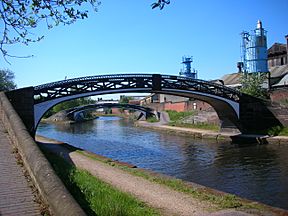Smethwick Junction (canal) facts for kids
Smethwick Junction is a special place on the Birmingham Canal Navigations (BCN) system. It's where the main canal line from Birmingham splits into two important routes: the BCN Old Main Line and the BCN New Main Line. You can find this junction near Smethwick in the West Midlands, England. Think of it like a crossroads for boats!
Contents
History of the Canals
Building the First Canal
The story of these canals began a long time ago. In 1768, a special law was passed to build the Birmingham Canal. This canal was designed to connect Birmingham to the Staffordshire and Worcestershire Canal at Aldersley Junction. Canals were like the motorways of their time, used to move heavy goods like coal and iron across the country.
The original canal had many locks. Locks are like water elevators that help boats move up or down hills. After Aldersley Junction, boats had to go through 20 (later 21) locks to climb 132 feet (40 meters). This part of the canal was called the Wolverhampton Level. Then, at Smethwick, boats went over a "summit" – the highest point – using more locks. After the summit, six locks lowered them down to the Birmingham Level, which led to the city.
Making the Canal Faster
As more and more goods were moved by canal, the Smethwick summit became a problem. There wasn't enough water, and too many boats caused traffic jams! To fix this, the canal company hired a famous engineer named Thomas Telford. He was asked to build a brand new main line.
Telford's new canal was much straighter than the old one. It used big cuttings (deep ditches dug through hills) and embankments (raised banks of earth) to avoid winding around the landscape. This new route, now called the New Main Line, made the journey about 7.5 miles (12 km) shorter!
Work on Telford's new line started in 1823. It was a huge project, and it wasn't fully finished until 1838. The new line bypassed the Smethwick summit with a massive cutting, which was up to 71 feet (22 meters) deep in some places. The original, winding canal was kept and became known as the Old Main Line.
Smethwick Junction was created when the old and new main lines joined together at the eastern end of the Smethwick cutting. This important junction opened on December 18, 1829. Another similar junction, Bromford Junction, was built at the western end of the cutting.
Smethwick Junction Today
Smethwick Junction is a fascinating place to visit. It features two beautiful Horseley Ironworks roving bridges, which were built in 1828 as part of Thomas Telford's improvements.
The Roving Bridges
These special bridges are designed so that horses pulling boats could cross from one side of the canal to the other without having to unhitch from the boat. One bridge crosses the New Main Line just east of the junction, and the other crosses the Old Main Line to the west.
Each bridge is 52.5 feet (16 meters) wide, and its arch rises 9 feet (2.7 meters) high. The unique semi-elliptical shape gives more space for boats and towpaths underneath. The bridges are made of cast iron plates with raised ribs, which helped keep the earth filling in place for the walkway.
You can still see deep marks on the ironwork of these bridges. These marks were made by the ropes used to pull the boats, showing how much traffic passed through here long ago! Both bridges are protected as Grade II listed structures, meaning they are historically important. The bridge to the west is in better condition, as the eastern one had some repairs in the 20th century.
Canal Routes from the Junction
From Smethwick Junction, the New Main Line heads east. It's a flat, level stretch for about 2.6 miles (4.2 km) until it reaches Worcester Bar. This is where it connects with the Worcester and Birmingham Canal. This part of the canal has towpaths on both sides, perfect for walking or cycling.
If you head in the other direction, the New Main Line goes straight for about 5.5 miles (8.9 km) to the bottom of the three Factory Locks. These locks raise the canal up to the Wolverhampton Level.
The Old Main Line turns north from the junction. It runs mostly parallel to the New Main Line. Just past the junction, you'll find the three Smethwick locks. These locks were duplicated in the 1790s to speed up boat traffic. They raise the canal 20 feet (6.1 meters) from the Birmingham Level to the Wolverhampton Level. On this old line, there's only a towpath on the south bank. Water for the summit is supplied by the Smethwick pumping station, which pumps water from the lower canal level.


